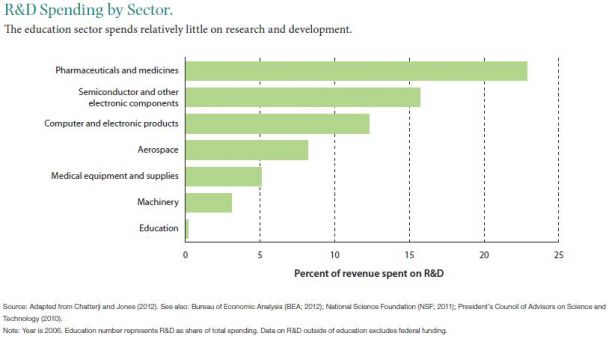In the modern economy, innovation drives growth. From the telegraph to the telephone to the Internet, new technologies increase productivity and allow Americans to prosper. But while innovation has revolutionized the American economy as a whole over the last century, the education sector has benefitted relatively little from these advances.
Although computers and Smartboards are becoming increasingly common in the nation’s classrooms, over the past three decades average math and reading test scores of American seventeen-year-olds have remained largely unchanged. Meanwhile per-pupil spending has almost doubled. This increase in spending partially reflects that schools must compete to hire college-educated teachers in a labor market where well-educated workers command higher and higher salaries, but it also indicates that innovation and increases in productivity have occurred faster and been more effective in the broader economy than in the field of education.
In other words, education has faced a relative innovation deficit. Overall, the United States spends about three percent of its total expenditures on research and development (R&D), with that figure reaching as high as 23 percent in pharmaceuticals (see figure below). In education, however, only 0.2 percent of expenditures are spent on R&D.
Increasing productivity and innovation requires identifying promising approaches, testing those approaches rigorously, and disseminating results. In a forthcoming Hamilton Project discussion paper, “Harnessing Technology to Improve K–12 Education,” Aaron Chatterji of Duke University and Benjamin Jones of Northwestern University put forward a proposal for making the marketplace for education technologies transparent, thus unleashing the powers of innovation in education.
This proposal, and other ideas to improve America’s schools, will be released on September 27th as part of a Hamilton Project event focusing on the value of education, and opportunities to promote attainment and achievement in our K-12 system. U.S. Secretary of Education Arne Duncan will give featured remarks, highlighting recent progress on education reform, the difficult work still ahead, and the need for innovation to help advance reform efforts. Harvard University Professor Roland Fryer, a recent MacArthur Foundation Genius Award Winner; Terry Grier, Superintendent of the Houston Independent School District; Dennis Van Roekel, President of the National Education Association; Karen Cator, Director of the U.S. Department of Education’s Office of Educational Technology, and LearnZillion Founder Eric Westendorf are among the participants in the panel discussions.
On Tuesday, September 25th The Hamilton project will host media calls to discuss two of the new papers being released as part of next Thursday’s event. Please let us know if you are interested in joining one or both of the calls and we will send you the embargoed paper(s) for review.
Information For September 25TH Media Calls
1. Tuesday, September 25th at 1:30 p.m. ET – Call with authors Aaron K. Chatterji (Duke) and Benjamin Jones (Northwestern) to discuss their new paper, “Harnessing Technology to Improve K-12 Education.” Dial in number: 877-853-7709; paper summary included below.
2. Tuesday, September 25 at 4:00 p.m. ET – Call with Hamilton Project Director Michael Greenstone and Policy Director Adam Looney to walk through new data included in The Hamilton Project’s forthcoming policy memo, “A Dozen Economic Facts about Education.” Dial in number: 800-410-4983; paper summary included below.
Paper Summaries:
“Harnessing Technology to Improve K-12 Education”: Technological progress has consistently driven remarkable advances in the U.S. economy, yet K-12 education sees little technological change compared to other sectors, even as U.S. K-12 students increasingly lag behind students in other nations. This proposal considers how we can take a signature American strength— innovation—and apply it to K-12 education. Education technologies hold promise for personalized learning and for building basic skills, but a fundamental obstacle remains: the effectiveness of learning technologies is rarely known. Not surprisingly, when no one knows what works, schools are unlikely to buy, and innovators are unlikely to create. Building on the Common Core State Standards and increasing access to broadband internet, this paper proposes the establishment of a new third-party ratings organization to overcome this challenge. The proposed EDU STAR system would conduct rapid, low-cost evaluations of technologies and report the results to the public, speeding the development of a dynamic market for education technologies.
“A Dozen Economic Facts about Education”: These economic facts about education help illustrate the state of educational attainment in the United States and the growing importance of education in determining people's well-being. On many dimensions—lifetime earnings, incarceration rates, and life expectancy, to name a few—Americans who do not graduate from high school or college are increasingly falling behind those with a college degree. This paper explores both the condition of education in the United States and the economic evidence on several promising K-12 interventions that could improve the lives of Americans.
More information on the September 27th education forum can be found by clicking here.




